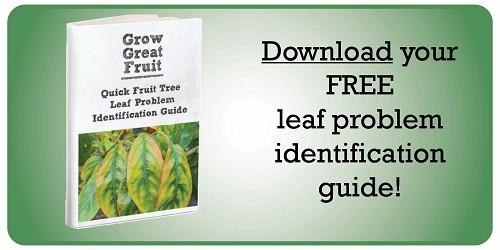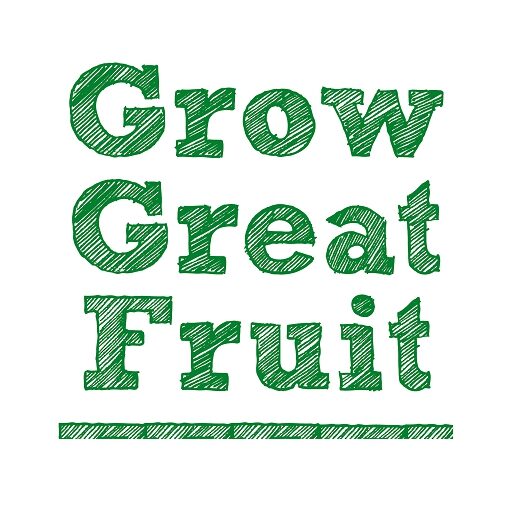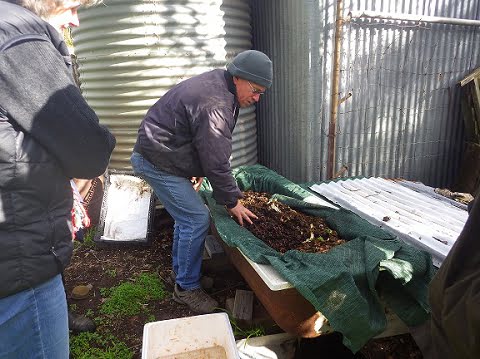Yellow Leaves on Fruit Trees
Yellow leaves on fruit trees can be a cause for concern, but they don’t always indicate a problem. Sometimes, they’re just part of the tree’s natural cycle.
Here’s What You Need to Know
Watching the leaves turn yellow, orange, red, and brown is a beautiful part of the natural flow of the seasons in your garden. It’s a visual reminder that it’s time to slow down.
However, when yellow leaves are also curly, or you can see other problems with the leaves such as curling leaves on your apple tree, it’s time to start trying to figure out what your fruit tree is trying to tell you.
In this guide, we’ll walk you through:
- Common causes of yellow leaves on fruit trees
- How to diagnose what’s happening with your tree
- Solutions and treatments to restore healthy green growth
- Tips for prevention so you can keep your fruit trees thriving year after year
Let’s get started — your trees will thank you.

Access our Quick Leaf Problem Identification Guide
It covers the common leaf issues you’re likely to see to help you diagnose and fix leaf problems quickly, so your trees stay healthy and productive.
Common Reasons Why Fruit Tree Leaves Turn Yellow
Several factors can lead to yellow leaves on your fruit trees. Understanding possible causes is the first step in deciding if you need to do anything.
One of the most common reasons for yellowing leaves is the change of seasons. The natural process of senescence occurs, which is a fancy word for the tree’s transition into dormancy.
As autumn approaches, many fruit trees start pulling nutrients back into their buds, bark, and roots. That makes the leaves change color and fall off. The process stores the tree’s energy over winter and prepare for the cold months.
If your tree is otherwise healthy and the yellowing occurs in autumn, there is no need for concern. However, if leaves turn yellow at other times of the year, it could indicate another issue.
How to Diagnose Yellow Leaves on Your Fruit Tree

Access our Quick Leaf Problem Identification Guide
It covers the common leaf issues you’re likely to see to help you diagnose and fix leaf problems quickly, so your trees stay healthy and productive.
Not all yellow leaves are a cause for concern—sometimes, it’s just your tree’s natural cycle. For instance, in autumn, deciduous fruit trees like apples and plums naturally shed their leaves as they enter dormancy.
However, if you notice yellowing leaves during the growing season, it’s time to play detective.
Start by considering the timing and pattern: are all trees affected or just one? Is the yellowing uniform or patchy?
Common culprits include water stress (either too much or too little), nutrient deficiencies (like iron or nitrogen), pest infestations (such as aphids), and diseases (like apple mosaic virus).
Observing additional symptoms—like leaf curling, mottled patterns, or dieback—can provide further clues. By closely monitoring these signs, you can identify the underlying issue and take appropriate action to restore your tree’s health.
Read on for more information and treatment for likely causes or download our handy Quick Guide to Leaf Problems.
Not all yellow leaves are a cause for concern—sometimes, it’s just your tree’s natural cycle. For instance, in autumn, deciduous fruit trees like apples and plums naturally shed their leaves as they enter dormancy.
However, if you notice yellowing leaves during the growing season, it’s time to play detective.
Start by considering the timing and pattern: are all trees affected or just one? Is the yellowing uniform or patchy?
Common culprits include water stress (either too much or too little), nutrient deficiencies (like iron or nitrogen), pest infestations (such as aphids), and diseases (like apple mosaic virus).
Observing additional symptoms—like leaf curling, mottled patterns, or dieback—can provide further clues. By closely monitoring these signs, you can identify the underlying issue and take appropriate action to restore your tree’s health.
Read on for more information and treatment for likely causes or download our handy Quick Guide to Leaf Problems.
Water as the Cause of Yellow Leaves, and the Solution
If yellow leaves appear during the growing season, inadequate water could be the culprit. Trees rely on consistent moisture to stay healthy, and a blocked irrigation system, extended drought, or poor soil drainage can quickly lead to stress. Unfortunately, too much water can produce similar symptoms!
Signs of water stress often show up unevenly, with affected trees displaying yellow leaves while neighboring trees remain green. Dry weather poses particular challenges, but with careful water management, it is still possible to grow fruit in a drought.
If you think water might be involved:
- Make sure the tree is getting enough water
- Check the drainage and improve if necessary
- Consider ways to capture rainfall in a way that is good for your soil.
Nutrients as the Cause of Yellow Leaves on Your Fruit Trees and Solution
As you’ve seen there are lots of different possible causes for yellow leaves. Identifying the cause will point you in the direction for the appropriate solution to restore your tree’s health.
Lack of nutrients in the soil can also cause yellowing leaves. The deficiencies are often essential nutrients like iron, manganese, and zinc. This is especially common in fruit trees grown in sandy or depleted soils. Citrus trees, for example, often show yellowing along the veins due to iron deficiency, a condition known as chlorosis.
Pattern of yellowing
- Uniform yellowing across older leaves → Often points to nitrogen deficiency. The tree starts pulling nitrogen from older leaves to feed new growth.
- Yellowing between leaf veins (while veins stay green) → A classic sign of iron deficiency (called interveinal chlorosis). Common in high pH (alkaline) soils.
- Patchy yellowing or pale new growth → May indicate magnesium, manganese, or zinc deficiencies.
Which leaves are affected?
- Older leaves first → Nitrogen, magnesium deficiency.
- Newer leaves first → Iron, zinc, and manganese deficiency. (These nutrients can’t move easily inside the plant, so deficiencies show up in young leaves first.)
Other plant signs
- Stunted growth
- Poor flowering or fruiting
- Weak or thin branches
- Leaf drop
Timing and conditions
- Follows heavy rain or prolonged wet conditions → Nutrients may have leached from the soil.
- After periods of fast growth or fruit production → The tree may be using more nutrients than usual.
- Soil known to be depleted or not fertilised recently.
Rule of thumb:
- If you see even yellowing across the whole tree, or specific patterns like interveinal yellowing, nutrition is a likely cause.
- If yellowing is patchy, random, or comes with spots, pests, or leaf distortion — think about pests, disease, or water stress first.
If the problem seems to be nutritional:
- Apply compost, aged manure, or worm castings to improve soil fertility.
- Compost tea can help to fix yellow leaves by introducing beneficial microbes and enhance nutrient availability.
- Grow diverse understory beneath your fruit trees.
Should you do a soil test?
In most cases, the answer is no, unless you suspect your soil may be contaminated. Soil tests are expensive and often give gardeners too much information, with not enough guidance about how to fix any imbalances that are identified.
In most cases, we’re not fans of adding specific nutrients to the soil. Soil science is complex, and nutrients react with each other in complex ways. If you start adding specific nutrients like nitrogen, potassium, or magnesium to correct a suspected or known deficiency, it’s easy to do more harm than good.
Luckily, there are a number of free soil tests you can do at home. These will help you understand your soil better and identify nutrient issues. If you suspect a nutrient deficiency, the best strategy is to improve your overall soil health with these 3 simple strategies.
Can pests and diseases cause yellow leaves?
Absolutely! In fact, disease is one of the most common reasons your fruit tree leaves might turn yellow. This is especially true for citrus trees, where leaves often turn yellow and become curly at the same time. Some pests can also trigger yellow leaves.
Some of the symptoms to watch for include:
- mottled patterns
- dieback
- cankers
- sticky residue
- visible insects, or
- distorted growth.
The Impact of Yellow Leaves on Your Harvest
Yellow leaves directly affect your tree’s ability to produce quality fruit. Photosynthesis—the process that converts sunlight into energy—mainly occurs in healthy green leaves. If you can’t see green, it’s not happening.
When leaves yellow prematurely, this vital process is compromised. The result is often smaller fruits with less flavour and reduced sugar content. In fact, trees with significant leaf yellowing before harvest can produce fruits with up to 30% less sugar.
If your leaves are yellow due to poor soil or a nutrient deficiency, this can also affect fruit development. Your fruit might taste more bitter, have worse colour, or be more likely to experience sunburn.
Keeping on eye on leaf health throughout the growing season allows you to catch problems before they impact your fruit quality.
Climate Change and Yellow Leaves
Changing climate patterns are creating new challenges for fruit tree growers. Rising temperatures, shifting rain patterns, and longer growing seasons are altering how trees respond to their environment.
The good news is that growing fruit trees can be a climate change solution!
Many regions are experiencing extended heat waves and drought conditions that stress trees and trigger premature yellowing. Winter warming trends can also confuse fruit trees’ natural dormancy cycles, causing them to break dormancy too early and become vulnerable to late frosts—resulting in stress responses like yellowing.
Some traditional fruit-growing regions are becoming less suitable for certain varieties. Luckily, your backyard is always going to be the perfect place to grow fruit!
Adapting to these changes may require selecting more resilient varieties and adjusting care practices to support trees through environmental stress. There are some great resources available to help home gardeners adapt.
Need more help? Check out our fruit tree leaf resources
Still unsure what’s causing the problem with your fruit tree leaves?
Don’t worry, we can still help! Leaf issues can be tricky to diagnose because they can be caused by so many different things. The good news is, we’ve put together plenty of resources to help you delve deeper.
🍃 Download Quick Leaf Problem Identification Guide
🍃 Understanding and treating leaf curl
Get our FREE ebook – 10 Key Steps to Growing Great Fruit
Our useful ebook will give you answers to all the fruit growing topics you need to know about. This handy little guide includes everything from pests to pruning. It normally costs $19.95, but you can get your copy completely free!

Access our Quick Leaf Problem Identification Guide
It covers the common leaf issues you’re likely to see to help you diagnose and fix leaf problems quickly, so your trees stay healthy and productive.




